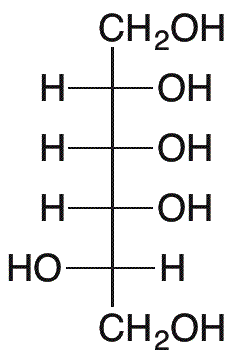L-Talitol is widely utilized in research focused on:
- Pharmaceutical Formulations: It serves as a sugar alcohol that can be used as a sweetener and bulking agent in various medications, enhancing taste without contributing to calories.
- Food Industry: As a low-calorie sweetener, L-Talitol is incorporated into sugar-free products, catering to health-conscious consumers and those managing diabetes.
- Cosmetics: Its moisturizing properties make it an ideal ingredient in skincare products, helping to improve skin hydration and texture.
- Biotechnology: L-Talitol is used in the formulation of culture media for microbial growth, supporting research in microbiology and biotechnology.
- Dental Products: It is included in toothpaste and mouthwashes due to its non-cariogenic nature, promoting oral health without promoting tooth decay.
General Information
Properties
Safety and Regulations
Applications
L-Talitol is widely utilized in research focused on:
- Pharmaceutical Formulations: It serves as a sugar alcohol that can be used as a sweetener and bulking agent in various medications, enhancing taste without contributing to calories.
- Food Industry: As a low-calorie sweetener, L-Talitol is incorporated into sugar-free products, catering to health-conscious consumers and those managing diabetes.
- Cosmetics: Its moisturizing properties make it an ideal ingredient in skincare products, helping to improve skin hydration and texture.
- Biotechnology: L-Talitol is used in the formulation of culture media for microbial growth, supporting research in microbiology and biotechnology.
- Dental Products: It is included in toothpaste and mouthwashes due to its non-cariogenic nature, promoting oral health without promoting tooth decay.
Documents
Safety Data Sheets (SDS)
The SDS provides comprehensive safety information on handling, storage, and disposal of the product.
Product Specification (PS)
The PS provides a comprehensive breakdown of the product’s properties, including chemical composition, physical state, purity, and storage requirements. It also details acceptable quality ranges and the product's intended applications.
Certificates of Analysis (COA)
Search for Certificates of Analysis (COA) by entering the products Lot Number. Lot and Batch Numbers can be found on a product’s label following the words ‘Lot’ or ‘Batch’.
*Catalog Number
*Lot Number
Certificates Of Origin (COO)
This COO confirms the country where the product was manufactured, and also details the materials and components used in it and whether it is derived from natural, synthetic, or other specific sources. This certificate may be required for customs, trade, and regulatory compliance.
*Catalog Number
*Lot Number
Safety Data Sheets (SDS)
The SDS provides comprehensive safety information on handling, storage, and disposal of the product.
DownloadProduct Specification (PS)
The PS provides a comprehensive breakdown of the product’s properties, including chemical composition, physical state, purity, and storage requirements. It also details acceptable quality ranges and the product's intended applications.
DownloadCertificates of Analysis (COA)
Search for Certificates of Analysis (COA) by entering the products Lot Number. Lot and Batch Numbers can be found on a product’s label following the words ‘Lot’ or ‘Batch’.
*Catalog Number
*Lot Number
Certificates Of Origin (COO)
This COO confirms the country where the product was manufactured, and also details the materials and components used in it and whether it is derived from natural, synthetic, or other specific sources. This certificate may be required for customs, trade, and regulatory compliance.


